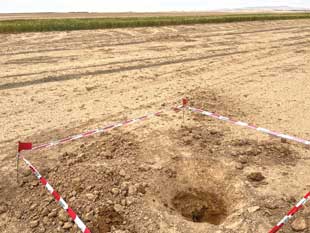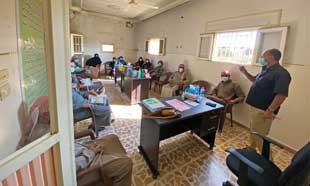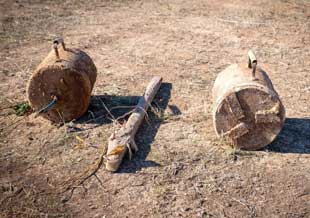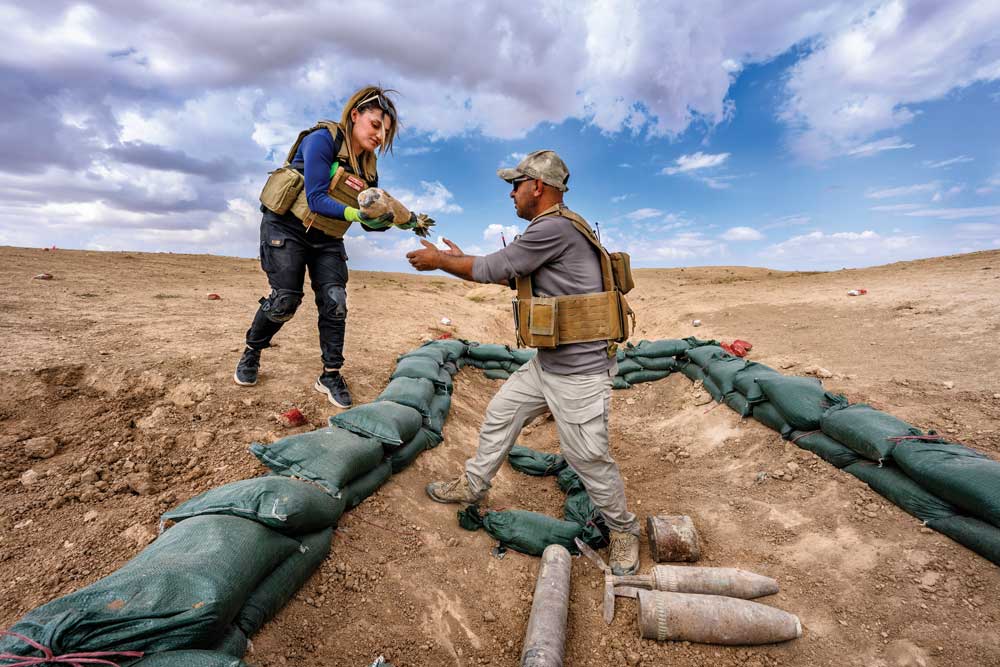Clear then Grow: Integrating Mine Action with Food Security in Northeast Syria
By Katarina Cvikl Balić [ ITF Enhancing Human Security ]
CISR JournalThis article is brought to you by the Center for International Stabilization and Recovery (CISR) from issue 26.1 & 2 of The Journal of Conventional Weapons Destruction available on the JMU Scholarly Commons and Issuu.com
Over the past several years, considerable attention within the mine action community and in the wider development sector has been devoted to conceptualizing mine action interventions within the broader sustainable development goals (SDGs), or more recently, the so-called triple nexus.1 Aiming to find linkages between, for instance, clearance efforts and food security is not a new concept. This article, however, looks at the operationalization of these links through an integrated mine action and agricultural recovery program within Northeast Syria (NES).2

The mine action community, including mine action organizations and traditional mine action donors, has invested considerable efforts into understanding how mine action can support the SDGs3 or the humanitarian development peace nexus. Also, it has been well-noted that mine action should not exist in silos but should seek to leverage its operations in collaboration with broader sustainable development and peace efforts.4 However, moving from a conceptual understanding of this idea to implementation has not been without its challenges. This is due in part to several factors, including the continuation of strongly-rooted practices within mine action, which are based on decades of expertise and strong relations within the community of practice, both internationally and in local capacities, but with limited outreach to the broader development sector. Additionally, limited mandates of mine action organizations make it difficult for operators to build internal expertise around the triple nexus, justify engagement in activities that traditionally are outside the scope of mine action, or make it difficult to partner and coordinate with other sustainable development or peace-focused organizations. Furthermore, donors specifically operating in mine action and those operating in the development sector may view their activities as autonomous and may have competing priorities.
Before the emergence of the SDGs, ITF Enhancing Human Security (ITF)5 had adopted this innovative thinking and attempted to reconceptualize seemingly “hard” mine action operations into “soft,” people-centered approaches, focusing on community needs more holistically. For years, ITF has worked to mobilize resources and address a wide array of donors and supporters whose interests lie in human security more broadly, rather than strictly within the mine action sphere. This multidimensional approach paved the way for ITF’s development of the "Clear then Grow" model, bringing together mine action response and agricultural recovery. The Clear then Grow model was developed specifically for the NES context between 2018 and 2019, shortly after the liberation from the ISIS occupation, and ahead of the October 2019 Turkish military action along the Operation Peace Spring border areas,6 as well as the global COVID-19 pandemic. The integrated model aims to present mine action as an enabling factor for sustainable development activities and long-term peace. Although developed for NES, it may be particularly relevant for other countries such as Ukraine where food security is of global concern.
Clear then Grow

Community members during a training on sustainable agricultural practices. Image courtesy of ITF.
The Clear then Grow project started in 2019 with financial support provided by donors usually operating outside of mine action, namely the Austrian Development Agency, the Slovenian Ministry of Foreign Affairs, and the Knights of Columbus. The three donors have generously supported this project in a phased approach since its inception in 2018. Phase I focused on setting up the mine action side of the project (clearance/explosive ordnance risk education (EORE)) while in phase II, an agricultural component was added to complement the mine action response. The project’s phase II ended in August 2022, and ITF may continue with phase III, which will seek to expand and build on lessons learned thus far.7
ITF communicated extensively with other mine action actors and stakeholders operating in NES and conducted field visits and surveys, finding that there were significant aspects in which mine action efforts in operation between 2018 and 2019 could be complemented with sustainable development activities. Contamination in NES is found in both urban and rural areas and includes improvised explosive devices (IEDs) and unexploded ordnance contamination located in border areas8 or where battles to expel ISIS were fought. Considering the absence of a national mine action authority at the time9 and lack of a centralized prioritization system or tasking, mine action activities in NES were mainly coordinated through the NES Mine Action Sub Working Group between mine action organizations,10 and locally through civil councils at city levels and the komin,11 or commune at community levels. In the absence of a formal mine action center, the coordination process depended on individual mine action organizations working in NES, with their own policies and procedures.

Explosive hazards found and removed in Northeast Syria. Image courtesy of ITF.
For ITF, strong community liaison and participation was seen as essential to a successful integrated project; not only to obtain or cross-check information on potential contamination and appropriate additional support, but also to garner community acceptance. Until 2019, relatively speaking, significant international attention and clearance priorities in NES were devoted to urban clearance and clearing vital infrastructure. However, as re-confirmed recently by Humanity & Inclusion’s Syria report, over a third of explosive accidents occurred in agricultural areas.12 As of 2022, the full extent of contamination in Syria, including NES, remains unknown.13 It is estimated, however, that over 27 million square meters of land in NES are contaminated with explosive hazards, and this does not consider re-contamination in Operation Peace Spring areas.14 Furthermore, explosive hazard contamination is often found in agricultural land, preventing its use and development. ITF’s exchange with local counterparts and their active participation resulted in numerous requests to focus on agricultural areas—areas of contamination that had not yet been prioritized.
Looking more in-depth into the opportunities and threats related to agricultural contamination, context analysis confirmed NES’s importance to the country’s agricultural output and the debilitating effects this sector has suffered due to the ISIS occupation. A majority of the population in NES continue to base their livelihoods on agriculture. Previously referred to as the breadbasket of Syria, NES used to account for seventy percent of Syria’s wheat and grain production.15
Bread is a staple of Syrian cuisine and inaccessibility of wheat, bread, or bakeries is often linked with food insecurity and poverty. The ISIS occupation had a multifaceted impact on agricultural livelihoods. ISIS looted and destroyed agricultural tools and equipment, cut down or burned orchards, forests, wheat fields, and other crops, and rendered agricultural land inaccessible with the laying of IED belts. Furthermore, irrigation pathways were interrupted by conflict and with dry, hot summers and cold winters, the land had become inaccessible, drought-ridden, and had not been cultivated for several years. By engaging a local partner and relying on local expertise, an agricultural and food security assessment was carried out to identify the best approaches that would help to reinvigorate the affected areas and assist the affected rural communities.
It was at the intersection of these findings that the Clear then Grow approach was developed with the purpose to maximize the impact of clearance efforts in NES. Given the particularly gruesome legacy of the ISIS occupation and profound and multifaceted humanitarian crises, it became evident that the sustainable development impact of mine action itself would be lacking without follow-on activities. Put simply, the beneficiaries of mine action efforts—especially clearance efforts—would be unable to utilize the released land productively or grow crops without external assistance due to a lack of financial resources. Even the simplest and cheapest agricultural inputs had become unaffordable.

Clearance staff ensure that explosive hazards are removed and temporarily stored safely. Image courtesy of Arne Hodalič/ITF.
The context, however, drastically changed in autumn 2019 with the onset of Operation Peace Spring, when all clearance efforts in NES were suspended. The suspension and evacuation of mine action organizations was prolonged due to the security risks. Just as organizations were planning their return to the area in 2020, the global COVID-19 pandemic halted these plans. These developments exacerbated humanitarian needs in NES and underpinned the need for an integrated approach in which the local population depended less on humanitarian assistance and increased their resilience. Although a very challenging time, the ITF project team was able to work with donors and adjust its response, namely ensuring the project relied on local assistance and expertise, with the long-term goal of national ownership.
The integrated Clear then Grow response was first and foremost, people-centered, and focused on extensive dialogue and outreach with local communities involving mukhtars,16 village elders, vulnerable groups, komin, civil councils, and special interest groups. Additionally, mine action operations including EORE and non-technical survey were a crucial part of the integrated approach. The ITF project team, including expat staff, devoted considerable time to building local relations based on appropriate risk assessments—living with the community as closely as possible, splitting bread and drinking chai. Trust was built over time, and this also paved the way for a local partner with existing expertise in food security and livelihood support to develop a context-specific agricultural recovery intervention.
With agricultural needs assessments in the planned area of operations showing that the two main impediments to farming were contamination (confirmed or suspected) and a lack of financial resources and/or available agricultural inputs (e.g., seeds or seedlings, fertilizers, water, farming tools), it was important for agricultural recovery to encourage income generation within the community. The value chain approach to agricultural recovery, which followed clearance efforts, included provision of support to barley farmers, sheep herders, and homeowners with vegetable gardens. This was implemented in recently cleared areas or areas impacted by explosive hazards contamination, following close coordination between the mine action team and the agricultural team. Direct support to farmers was provided in the form of know-how and technical knowledge (e.g., pest management or animal-friendly sheep rearing), but also basic agricultural inputs. Following ISIS occupation, countless farmers did not have shovels and hoes, and providing them with these tools was invaluable. Farmers were also provided with seeds, fertilizers, and means for pest management, or with sheep and adequate fodder, depending on their family’s livelihood.
This approach also included supporting small agribusiness development to boost sustainability within the community. Vulnerable populations living below the poverty line, including internally displaced persons (IDP) populations living in informal settlements, were provided with vouchers that were redeemable at local small businesses. This brought significant engagement and resources into communities that were previously living with the debilitating impact of explosive hazards, inaccessibility of their land, and the psychological impact of living in contaminated areas. Although the scale of contamination in the areas ITF worked in was not large, accidents that had occurred previously continued to instill fear within the community and prevented civilians from working their land. Overall, 340 families in two communities affected by explosive hazards were provided with support to help them rebuild their agricultural livelihoods. Over half of the families that received support were households headed by women, often supporting their extended families.
Challenges
The scale of the Clear then Grow project was relatively small, and may not have been broad enough to achieve full self-sustainability within the targeted communities. Additional support in the forms of establishing or refurbishing silos and mills, and ensuring reliable irrigation pathways is still required. Yet, the project did ensure that hundreds of families have directly improved food security and are able to subsist on agriculture again. A more in-depth impact analysis is ongoing, but regular monitoring and follow-up mechanisms have so far indicated that for many of the families, the support provided means that there is no longer the need to resort to negative coping strategies: borrowing money, selling the few assets they own, consuming low-quality food, reducing the number of meals per day, and stopping schooling of family members. With improved economic outlooks, extremist groups hold less appeal and this in turn leads to decreased violence.
With implementation of the Clear then Grow project, ITF encountered challenges and gained valuable lessons learned, all of which may help inform similar, future interventions.
- Resource mobilization for such initiatives is not without its challenges. In contrast to focusing on traditional mine action operations, and engaging with an agricultural partner that would ensure their own funding under a separate but complementary initiative, ITF’s approach was to do it “under one roof” and to ensure funding for the entire intervention—from clearance to agricultural initiatives. Trying to align separately funded organizations through mine action and non-mine action components would present an even bigger challenge with competing timelines, funding cycles, and/or unpredictable or contradictory donor requirements, etc.
- The disproportionality of costs between mine action and/or clearance efforts vs. agricultural support must be addressed. One of the challenges ITF experienced in its efforts to secure financial resources for the Clear then Grow program was the perception of costliness of mine action efforts (especially clearance) as compared to follow-on, development activities. While this may not be a new challenge for the mine action community, it becomes even more pronounced when raising funds for a joint program. An important part of the solution lies in continued awareness raising among donors, highlighting the complexities of mine action and why the costs of clearance efforts are relatively high, while at the same time ensuring that funds are used as efficiently and transparently as possible.
- There needs to be closer cooperation between the mine action and wider humanitarian and development sectors. There can be a disconnect between organizations clustered under the humanitarian and development sectors. Mine action is typically organized as the sub-cluster to the protection cluster in a humanitarian response. In order to ensure optimal efficiency, from initial planning stages to conducting operations and follow-on development activities, it would be beneficial for all actors involved to be in close communication and cooperation from the outset. This is especially true in areas of operation where there are no mine action centers or authorities, as other operators in the area may have information pertaining to potential contamination. Mine action partners, on the other hand, could share their work on agricultural lands for further food security/livelihoods initiatives. Regular exchange between organizations working locally could help bridge the gap in developing relevant partnerships and may enhance mine action’s integration into triple nexus initiatives.
- Local partnerships and expertise are key. Local knowledge on everything from potential contamination to cultural dynamics is vital for a program’s success. These can include knowledge of local grievances or tensions that may exist between host and IDP populations, local tribes, or other population groups. Engaging local partners that do not, for example, acknowledge the different needs of host and IDP populations or demonstrate an understanding of the need to “do no harm,” may further exacerbate intracommunal grievances that inadvertently result in the escalation of tensions within the community. This can have a major impact on a local community’s acceptance of an organization and influence future mine action operations and programming. It is also important to understand what the partner(s) can or cannot bring to the table. As experienced by ITF, there needs to be more rigor in measuring an integrated approach impact and the mechanisms and tools that need to be applied.
While ITF implemented the Clear then Grow program specifically in NES, we believe that the program could be applied in other regional contexts where contamination is impacting agricultural communities. Additionally, ITF considers that this is only one example of how mine action organizations and donors can look toward more integrated approaches. The Clear then Grow program is a model that encourages other actors to begin practically addressing not only the challenges, but also the opportunities presented by integrating mine action into the wider development sector in the interest of future mine action operations and for the benefit of the communities we aim to support.
 Katarina Cvikl Balić
Katarina Cvikl Balić
Head of Implementation Office in Iraq
ITF Enhancing Human Security
www.itf.si
Katarina Cvikl Balić is Head of Implementation Office in Iraq for ITF Enhancing Human Security, leading the development and implementation of ITF’s projects in Iraq and Northeast Syria. Her portfolio currently includes managing ITF’s project in the West Bank. She joined ITF in 2015 after working for a non-profit in Bosnia and Herzegovina. Cvikl Balić holds a master’s degree in International Development from the University of Manchester with a focus on post-conflict reconstruction.

